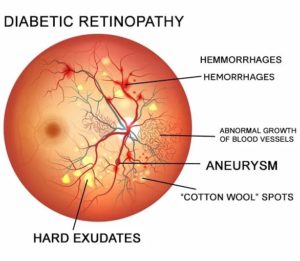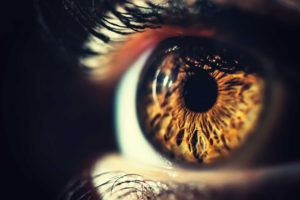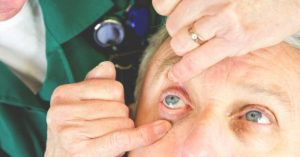Diabetic retinopathy
It is a diabetes complication that affects the eyes. Diabetic retinopathy is caused by damage to the blood vessels of the light-sensitive tissue at the back of the eye (retina).
Diabetic retinopathy is the most common form of diabetic eye disease. Diabetic retinopathy usually only affects people who have had diabetes. Retinopathy can affect all diabetics and becomes particularly dangerous, increasing the risk of blindness, if it is left untreated. The risk of developing diabetic retinopathy is known to increase with age as well as with poorly controlled blood sugar and blood pressure level.

Diabetic retinopathy is off 3 types –
- Background retinopathy
- Diabetic maculopathy
- Proliferative retinopathy
Let us get a little deeper into these three types;

Background retinopathy
Background retinopathy is an early stage of retinal damage when small blood vessels in the retina show signs of damage that can result from diabetes. And also it is said to occur if you have developed microaneurysms on your retina. when there is a swelling of the capillaries (very small blood vessels) that feed the retina. (or a tiny area of blood protruding from an artery or vein in the back of the eye)
Symptoms –
The signs of background retinopathy are usually only noticeable through a retinal screening once done, whereby a clear picture is been taken of your retina.
Risk Factors –
- Duration of diabetes — the longer you have diabetes, the greater your risk of developing diabetic retinopathy.
- Poor control of your blood sugar level.
- High blood pressure.
- High cholesterol.
- Tobacco use.
Diabetic maculopathy
Diabetic maculopathy is when the macula sustains some form of damage. One such cause of macular damage is diabetic macular oedema whereby blood vessels near the macula leak fluid or protein onto the macula.
Symptoms –
- Blurry vision
- Seeing colors that look washed out
- Seeing more floaters in your vision
- Double vision
Risk factors –
- Glycemic control
- Hypertension
- Dyslipidemia
- Nephropathy
- Anemia
- Sleep apnea
- Glitazone usage
- Pregnancy
Proliferative retinopathy
Proliferative retinopathy is the body’s attempt to save its retina but it can often lead to scarring of the retina and can cause the retina to detach, leading to blindness. Modern eye treatment can help to prevent blindness from occurring as a result of proliferative retinopathy.
The damaged blood vessels are not as effective at carrying oxygen to the retina, which can also cause damage. In the advanced stage, called proliferative retinopathy, new blood vessels grow in the eye. However, they are weak and may burst, causing bleeding in the eye.
Symptoms –
The progressive loss of vision, particularly in those who are not properly followed or treated.
Risk factors –
- Duration of diabetes
- 30-34 years of diabetes increase the risk of retinopathy by 65%
- Overt albuminuria ( urinary albumin excretion )
- High level of blood total cholesterol and LDL
- Others: race, cigarette smoking, alcohol

HOW IS DIABETIC RETINOPATHY CAUSED?
Diabetic retinopathy is caused by high blood sugar due to diabetes. Over time, having too much sugar in your blood can damage your retina — the part of your eye that detects light and sends signals to your brain through a nerve in the back of your eye (optic nerve).
HOW LONG DOES DIABETIC RETINOPATHY TAKE TO DEVELOP?
Although retinopathy usually does not appear for approximately five years after a type 1 diabetes diagnosis, it may already be present when type 2 diabetes is diagnosed. After 15 years of having diabetes, 98 percent of those with type 1 diabetes and 78 percent of those with type 2 have some degree of retinal damage.
THE SYMPTOMS OF DIABETIC RETINOPATHY?
These symptoms would get noticed only once the disease gets serious to the next level –
Symptoms include;
- Sudden changes in vision / blurred vision
- Eye floaters and spots
- Double vision
- Eye pain
The longer a person has diabetes, the greater the risk of developing diabetic retinopathy becomes. However, keeping blood glucose levels well-controlled can help to significantly slow down the development of retinopathy. People with diabetes should, however, be aware that a rapid improvement in blood glucose levels can lead to a worsening of retinopathy.
ARE THERE ANY WAYS TO PREVENT DIABETIC RETINOPATHY?
The risk of developing diabetic retinopathy can be lessened by taking the following precautions:
- Taking a dilated eye examination once a year
- Managing diabetes strictly through medicine, insulin, diet, and exercise
- Test blood sugar levels regularly
- Test urine for ketone levels regularly









